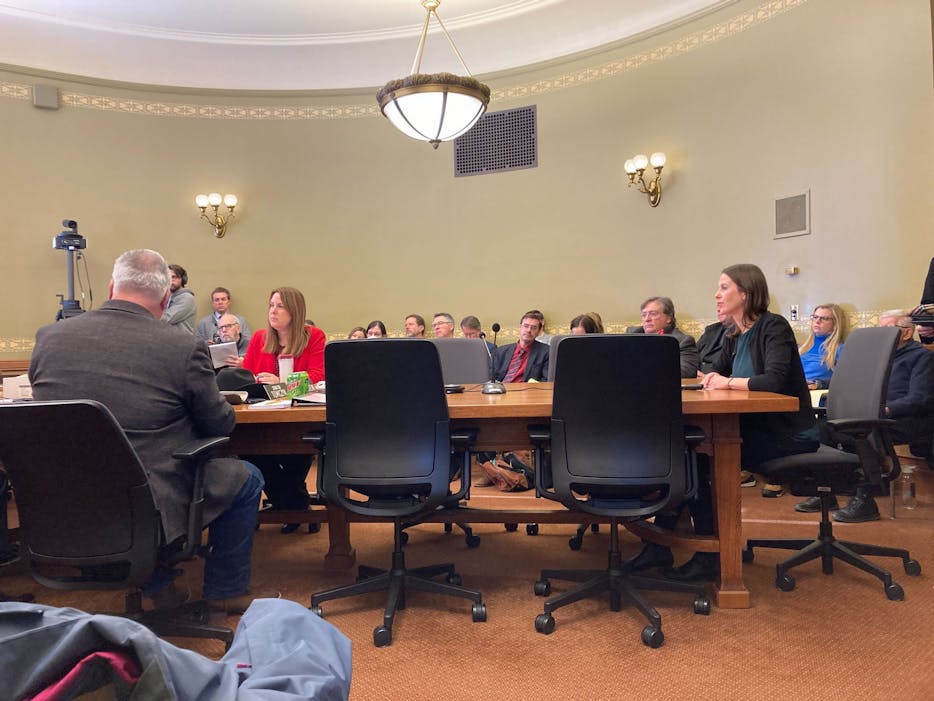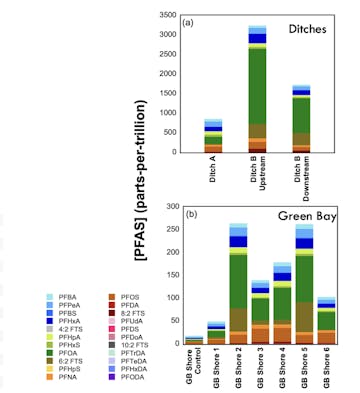The Senate Committee on Natural Resources and Energy held their first-ever informational hearing Tuesday morning on per-and polyfluoroalkyl substances (PFAS), a harmful water pollutant of growing concern among state officials.
Most commonly used in nonstick and waterproof commercial products, PFAS is the term for a variety of over 6,000 manufactured chemicals. When ingested, PFAS may cause health risks such as increased cholesterol and increased risk of cancer, according to the Centers for Disease Control. These health risks often come after prolonged exposure and accumulation of the chemicals in bodies.
Nicknamed “forever chemicals” for their inability to break down in the environment, PFAS have recently been found in water sources statewide. A November investigation from the Milwaukee Journal Sentinel found 30% of the 40 home taps they tested statewide contained PFAS concentrations above the recommended federal limit.

Multiple groups testified about their experiences researching and combating PFAS contamination before the committee Tuesday, including University of Wisconsin-Madison Professor of Environmental Engineering Christy Remucal.
In June 2022, the Environmental Protection Agency issued new guidelines for the maximum allowable amount of PFOA and PFOS — two common PFAS chemicals — in drinking water. Those guidelines recommended a maximum concentration of 0.004 parts per trillion for PFOA and 0.02 parts per trillion for PFOS.
In data presented to the Senate committee by Remucal, PFOA presence in Green Bay shore test sites far exceeded both the control site as well as EPA guidelines. PFOS presence in the Green Bay sites also exceeded both but by a smaller margin.
While Remucal introduced PFAS to the committee as chemicals found in everyday objects such as nonstick pans, Tuesday’s hearing centered around firefighting foam, as the amount of PFAS in it are “orders of magnitude higher” than in smaller objects, according to Remucal.
“How to fix it is hard. PFAS are really tricky,” Remucal said. “None of our usual approaches work on these chemicals.”
One company in particular, Tyco — a division of Johnson Controls — has been linked to the high levels in Green Bay. Remucal told the committee Tuesday that UW-Madison scientists were able to match the chemicals found in Green Bay to those in their firefighting foam.

Finding solutions
However, change is happening across Wisconsin. The Madison Fire Department replaced their firefighting foam with a PFAS-free alternative in 2019, and the Department of Natural Resources has begun an initiative to collect and dispose of at least 25,000 gallons of PFAS-containing firefighting foam across Wisconsin.
A state law passed in 2019 outlawed the use of PFAS-containing foam except in emergency cases or in a testing facility with appropriate containment procedures. Currently, 231 of 800 fire departments across Wisconsin are using PFAS-free foam, a number likely to grow as the DNR continues their initiative.
“Removing PFAS-containing firefighting foam from our local fire houses is an important step in not only protecting firefighters from occupational exposure to PFAS, but also protecting our land and water from contamination during emergency fire operations,” said DNR Secretary Preston D. Cole in an October press release.
David Johnson, executive vice president of North Shore Environmental Construction, told the committee Tuesday that some municipal fire departments may be hesitant to replace their foam due to costs.
“If each five-gallon bucket of foam is $100, then 10 of those would be $1,000, which for some departments is just not in the budget,” Johnson said.
Toni Herkert, government affairs director for the League of Wisconsin Municipalities, echoed Johnson’s point, suggesting that funding from the state could help individual cities battle PFAS contamination.
“Seed money for a revolving loan program might be a good thing to do with surplus dollars,” she said.
In December 2022, the city of Wausau unveiled a plant to filter PFAS out of water, almost a year after the city discovered all six of their city wells contained PFAS levels higher than 20 parts per trillion, according to Wisconsin Public Radio.
Wausau’s PFAS filtration plant is the first of its kind in Wisconsin. But, as Remucal explained Tuesday, filters would have to be replaced and discarded filters would have to be incinerated, a process that would cost the city around $800,000 annually, according to WPR. The city plans to replace the filter system with a permanent filtration system in the next two years, though that project has already put the city in a $15 million deficit.
As researchers look into alternate disposal methods, Remucal emphasized the need for preventative measures regarding PFAS contamination.
“Once they’re out there, they’re really hard to contain,” she said Tuesday. “Moving forward, what we really need to do is to prevent them from getting into the environment in the first place.”
During his Jan. 24 State of the State address, Gov. Tony Evers introduced his plan to fight PFAS in Wisconsin water sources. If passed by the Legislature, his pledge of more than $106 million would support municipalities in their initiatives to combat PFAS contamination as well as DNR staffing.
“The work we must do to address PFAS and other contaminants grows harder and more expensive with each day of delay,” Evers said during the address. “Partisan politics cannot keep getting in the way of this work while Wisconsinites worry about the water coming from their tap.”
The Democratic governor said the money — if approved — would be used to increase PFAS testing and monitoring, improve safety messaging across the state and ensure the Department of Natural Resources has full-time employees committed to fighting PFAS contamination statewide.
Despite worries over budget disagreements between the two parties as Evers finalizes his state budget, Sen. Robert Cowles (R-Green Bay), who chairs the committee, made sure to emphasize bipartisan support for the issue.
“Without knowing all the fine points,” Cowles said, “I think we’ve got a pretty good chance of making [the governor’s plan] happen, whether it’s a separate bill or in the budget.”
Annika Bereny is the campus news editor for The Daily Cardinal. She previously served as the special pages editor. As a staff writer, she's written in-depth on campus news specializing in protest policy, free speech and historical analysis. She has also written for state and city news. She is a History and Journalism major. Follow her on Twitter at @annikabereny.






